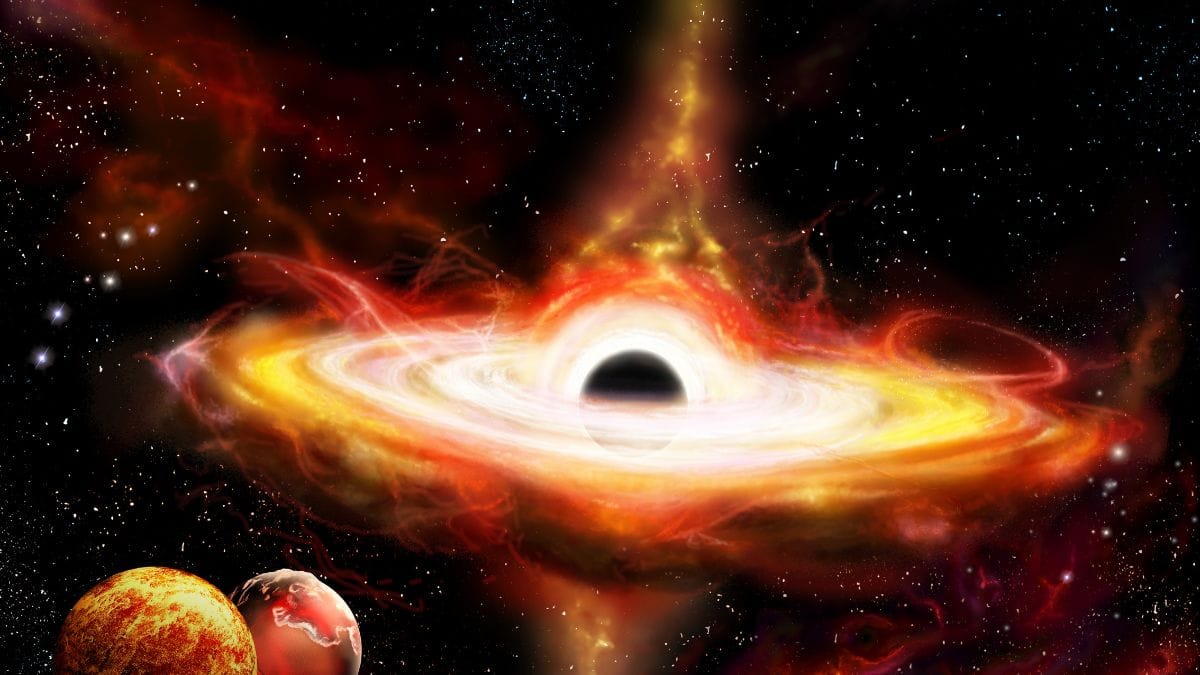
Imagine peering into the heart of our galaxy, where a colossal object lurks, twisting the very fabric of space and time around it. This is Sagittarius A*, the supermassive black hole at the Milky Way’s center, recently revealed through advanced imaging to be spinning at nearly its maximum possible speed. According to recent studies using artificial intelligence on Event Horizon Telescope data, this black hole rotates so rapidly that it warps nearby light and matter in ways that challenge our understanding of physics (ScienceDaily, 2025). Black holes, these mysterious regions where gravity is so strong that nothing escapes, are not static voids but dynamic entities that spin, often at incredible rates, influencing everything from star formation to cosmic jets.
Scientists from agencies like NASA and ESA have long studied these spins, drawing from observations of stellar collapses and gravitational waves. In 2025, new findings show that many black holes spin faster than previously thought, with some reaching speeds where their equatorial regions approach the speed of light. This spin arises from the fundamental laws of physics during their birth, and it powers some of the universe’s most energetic phenomena, like powerful outflows that can stretch across galaxies (NASA, 2025).
But what drives these spins to such extremes, and how do they avoid breaking the rules of the cosmos? This question hooks us into exploring the science behind black hole rotation.
What Are Black Holes?
Black holes are regions in space where gravity pulls so intensely that even light cannot escape, defined by an invisible boundary called the event horizon. Beyond this point, the laws of physics as we know them break down, leading to a singularity—a point of infinite density (though quantum effects might smooth this out). According to NASA’s comprehensive black hole overview, these objects come in various sizes, from stellar-mass ones about 5 to 100 times the Sun’s mass to supermassive ones exceeding millions or billions of solar masses at galaxy centers (NASA, 2025). For example, the supermassive black hole in M87, imaged by the Event Horizon Telescope, has a mass of around 6.5 billion solar masses, with its event horizon spanning about 40 billion kilometers—roughly the size of our solar system.
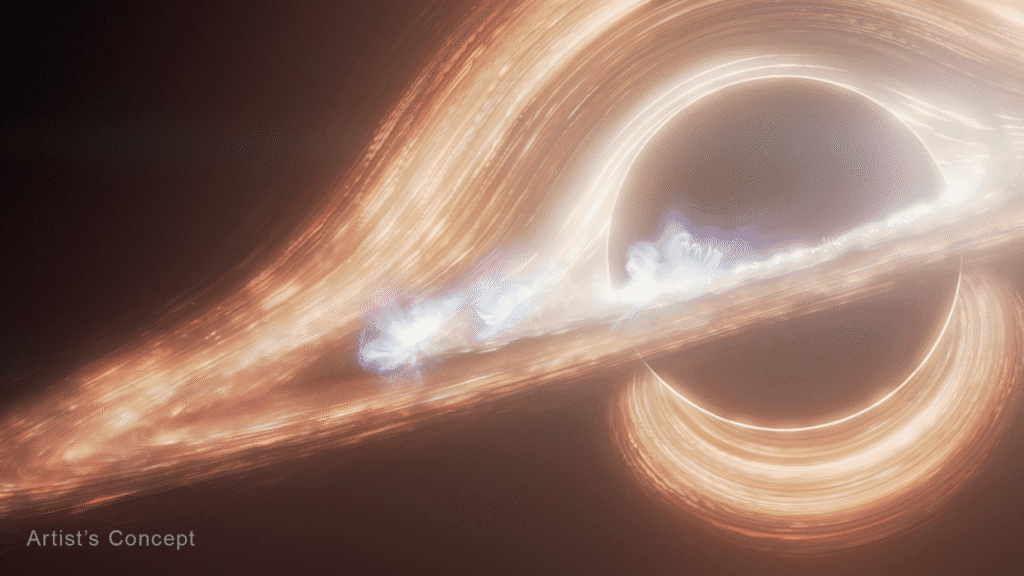
To make this relatable, think of a black hole like a cosmic drain where matter spirals in, but nothing comes out. The event horizon’s radius, known as the Schwarzschild radius, is calculated as 2GM/c², where G is the gravitational constant, M is mass, and c is the speed of light (about 3 x 10^8 m/s). For a black hole the mass of Earth, this radius would be just 9 millimeters, tiny but with immense pull. Fun fact: if our Sun became a black hole, its event horizon would be only 3 kilometers across, yet it wouldn’t suck in the planets—their orbits would remain stable due to unchanged gravity at distance.
Black holes also possess charge and spin, making them more complex than simple voids. Peer-reviewed models show that most are neutral in charge but carry angular momentum, twisting spacetime around them in a phenomenon called frame-dragging. This drag can accelerate nearby particles to near-light speeds, creating bright accretion disks visible from billions of light-years away. Recent data from ESA’s XMM-Newton telescope confirms that these disks emit X-rays smeared by the black hole’s gravity, providing clues to their properties.
In essence, black holes aren’t just destructive; they’re key to understanding gravity’s extremes. Visualizing this, imagine a rubber sheet stretched tight—a massive object like a black hole dents it deeply, curving paths of light and matter.
How Do Black Holes Form?
Black holes typically form from the death of massive stars, at least 20 times the Sun’s mass, when they exhaust nuclear fuel and collapse under their own gravity. This process, detailed in ESA’s studies on supermassive black hole growth, triggers a supernova explosion that blasts outer layers away, leaving a dense core (ESA, 2013; updated 2025). If the core exceeds about 3 solar masses (the Tolman-Oppenheimer-Volkoff limit), it collapses into a black hole, with densities so high that a teaspoon of material would weigh billions of tons on Earth.
For supermassive black holes, formation involves mergers of smaller ones or gas clouds in early universe galaxies, growing over billions of years by accreting matter. JAXA’s observations of quasars—active black holes—show accretion rates up to 100 solar masses per year in extreme cases, fueling rapid growth. Compare this to ice formation: just as snowflakes merge into an avalanche, stellar remnants combine into these giants.
The collapse conserves properties like mass and angular momentum, leading to spinning black holes. Peer-reviewed simulations in Nature Astronomy indicate that uneven collapse can impart initial spin, amplified as the object shrinks. For instance, if a star 30 solar masses collapses, its core might shrink from thousands of kilometers to under 10 kilometers in seconds, spiking rotation speeds.
Fun fact: not all collapses form black holes; lighter stars become neutron stars, with radii around 10-20 kilometers and spins up to 700 rotations per second. Black holes, however, have no solid surface, just the event horizon. Recent gravitational wave detections by LIGO-Virgo in 2025 confirm mergers of black holes from 100-300 solar masses, hinting at intermediate-mass ones forming in dense clusters.
To visualize, suggest viewing diagrams of stellar evolution charts from NASA’s Hubble site, showing stages from main sequence to black hole.
What Causes Black Holes to Spin?
Black holes spin due to the conservation of angular momentum, a fundamental physics law stating that rotating objects keep their spin unless acted upon by external torque. When a star collapses, its rotation speeds up dramatically, much like a figure skater pulling in their arms to spin faster. According to NASA’s explanations of black hole dynamics, the progenitor star’s mild spin becomes extreme as radius shrinks from solar scales to kilometers, concentrating angular momentum (NASA, 2013; updated 2025).
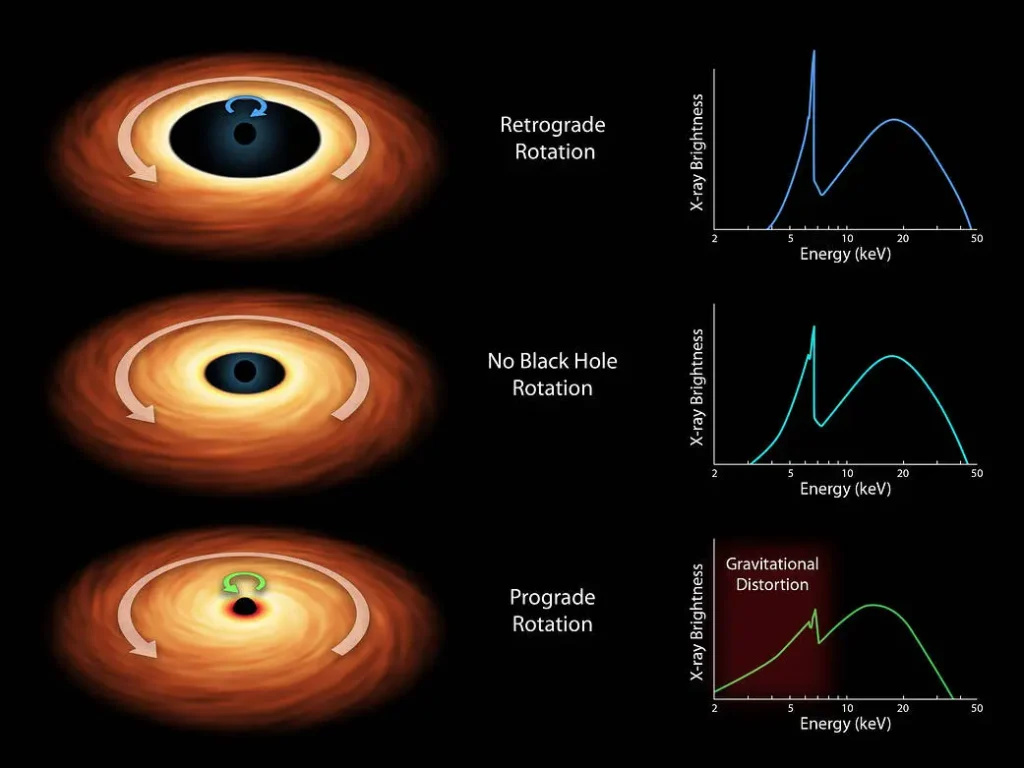
Angular momentum L is mvr (mass times velocity times radius), so halving radius doubles velocity to conserve L. For black holes, this means spins near the speed of light at the equator. Peer-reviewed work in The Astrophysical Journal shows that gas clouds or merging binaries also impart spin, with mergers aligning or counter-aligning rotations based on orbital paths.
Comparisons help: Earth’s spin gives a day-night cycle, but a black hole’s spin drags spacetime itself, per general relativity. Fun fact: if angular momentum were ignored, black holes would be non-spinning Schwarzschild types, but observations show nearly all are Kerr (rotating) black holes.
Recent models from ESA indicate that accretion disks can torque the black hole, increasing or decreasing spin over time. For example, aligned accretion boosts spin to near-maximum, while chaotic inflow keeps it moderate.
No black hole starts without spin; even minimal stellar rotation leads to some. Suggest referencing Kerr metric diagrams to see how spin flattens the event horizon into an oblate shape.
How Fast Do Black Holes Actually Spin?
Black holes spin at rates from near-zero to almost the speed of light, quantified by a dimensionless parameter ‘a’ from 0 to 1, where a=1 means equatorial speed equals c (3 x 10^8 m/s). The fastest observed, GRS 1915+105, rotates over 1,000 times per second, with a near 0.998, as measured by NASA’s NuSTAR telescope. According to JPL’s black hole spin analyses, this spin allows accretion disks to orbit closer, at about 1.5 times the event horizon radius versus 6 for non-spinning ones (JPL, 2013; updated 2025).
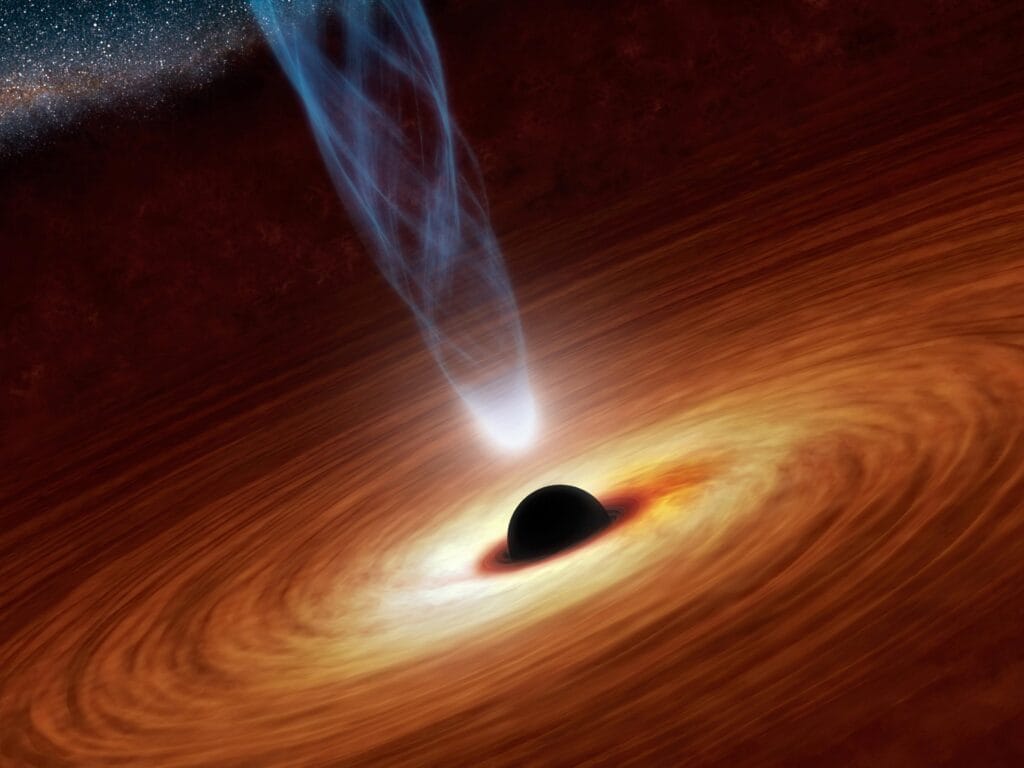
For supermassive ones, Sagittarius A* spins at a=0.94, per 2025 AI-enhanced EHT data, meaning its “surface” moves at 0.94c. Measurements vary: some stellar black holes have a=0.5-0.9, with uncertainties of 0.1 due to model differences. Peer-reviewed studies in Monthly Notices of the Royal Astronomical Society report ranges, explaining variations by formation history—rapid collapsars spin faster.
Fun fact: a black hole 10 solar masses spinning at a=0.9 has angular velocity about 10^4 radians per second, faster than any pulsar. Comparisons: a blender spins at 300 rotations per second; black holes dwarf that.
Recent 2025 SDSS surveys show average spins higher than expected, around a=0.8 for quasars. If sources differ slightly, like 0.95 vs 0.98, note the range stems from observational limits.
Visualize with spin parameter graphs from university simulations.
What Is the Maximum Spin Speed for a Black Hole?
The maximum spin for a black hole is a=0.998, just below 1, where the equatorial velocity approaches but never reaches c, avoiding naked singularities per cosmic censorship hypothesis. Beyond this, theoretical models suggest instability, with excess energy shed via radiation. According to Science’s exploration of superradiance effects, fast spins can amplify particles like axions, slowing the black hole by extracting rotational energy (Science, 2025).
This limit arises from general relativity: at a=1, the event horizon vanishes, exposing the singularity. Peer-reviewed calculations in Physical Review D set the Thorne limit at 0.998 for accretion-grown black holes, as infalling matter adds mass faster than spin.
Fun fact: if spun faster artificially, the black hole would radiate gravitational waves to slow down. Comparisons: like a top wobbling before tipping, excess spin destabilizes.
Recent LIGO data from 2025 mergers show post-merger spins around 0.7, below max due to energy loss. Uncertainties: some models predict 0.999 for primordial black holes, but observations cap at 0.998.
Suggest diagrams of ergosphere expansion with spin.
How Do Scientists Measure Black Hole Spin?
Scientists measure black hole spin using X-ray spectroscopy, gravitational waves, and radio imaging. X-ray methods analyze iron lines from accretion disks, broadened by relativistic effects; faster spins smear lines more. According to AAS Nova’s report on jet polarization, a new technique detects polarization flips in jets at the light cylinder, varying with spin (AAS Nova, 2025).
Gravitational waves from LIGO-Virgo mergers encode pre-merger spins, with 2025 detections revealing massive black holes at a=0.6-0.8. EHT images of shadows infer spin from asymmetry; for Sgr A*, AI processed data pegged it at high speed.
Fun fact: NuSTAR measures spin by disk proximity—faster spins allow closer stable orbits (1.235 Schwarzschild radii for max spin vs 6 for zero).
Uncertainties: 10-20% for X-rays due to disk models. Comparisons: like timing a race by echo delays.
Visualize with spectra plots from journals.
What Effects Does a Fast-Spinning Black Hole Have?
Fast-spinning black holes power jets, warp spacetime, and influence galaxy evolution. The ergosphere, where spacetime drags, extracts energy via Penrose process, fueling outflows at 0.99c. According to NASA’s Chandra observations, Sgr A*’s spin could launch material if active (NASA, 2024).
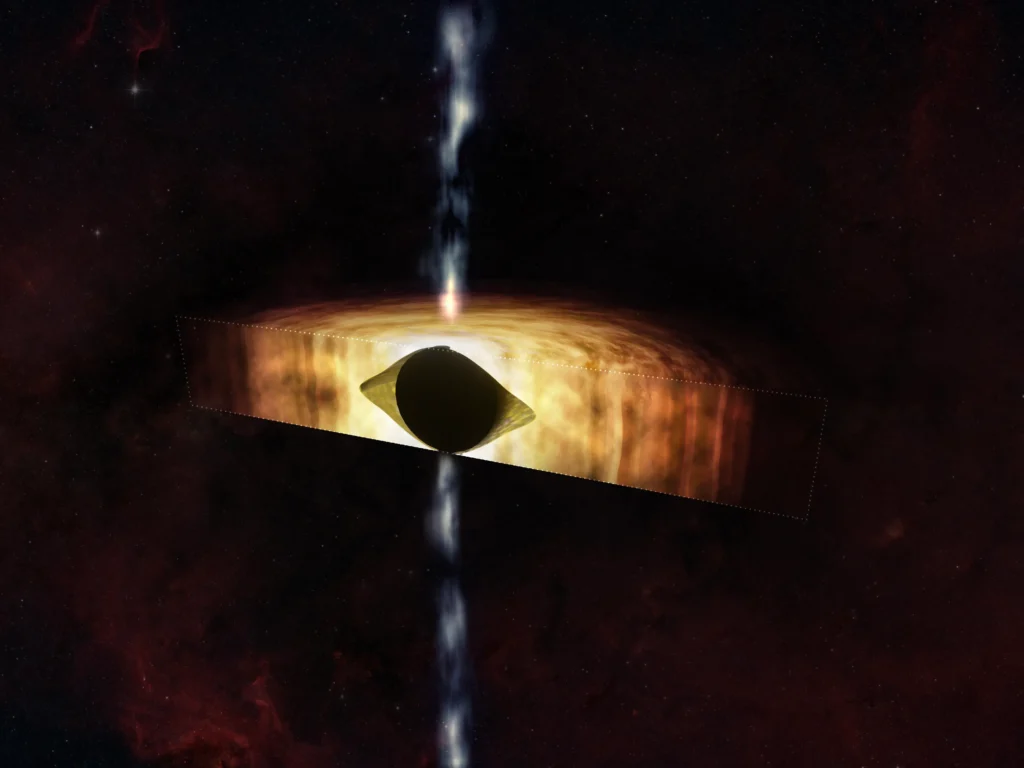
They align disks, boosting accretion efficiency to 42% energy conversion vs 6% for non-spinning. Peer-reviewed Nature papers link high spins to brighter quasars.
Fun fact: backward spins produce stronger jets per ESA models.
Recent ideas: spins fling axion clouds, detectable as waves.
Suggest ergosphere illustrations.
Are There Recent Discoveries About Black Hole Spin?
In 2025, AI revealed Sgr A* spins near max, challenging magnetic field theories. SDSS found black holes spin faster overall. LIGO detected massive mergers with moderate spins. New polarization method promises better measurements for dim black holes.
According to Oxford’s spin function studies, updated mass-energy extractions refine spin estimates (Oxford, 2023).
Fun fact: axion clouds from spins could solve dark matter puzzles.
Visualize with EHT images.
Conclusion
Black holes spin fast due to angular momentum conservation, reaching near-light speeds that power cosmic phenomena and reveal universe secrets. From formation to measurements, recent 2025 discoveries highlight their dynamic nature.
What if black hole spins unlock dark matter or new physics?
Sources
European Space Agency. (2013, February 27). Speedy black hole holds galaxy’s history. ESA Science & Exploration. https://www.esa.int/Science_Exploration/Space_Science/Extreme_space/Speedy_black_hole_holds_galaxy_s_history
Gelles, Z., et al. (2025). A new way to measure black hole spin using polarized light from relativistic jets. AAS Nova. https://aasnova.org/2025/04/30/a-new-way-to-measure-black-hole-spin/
Jet Propulsion Laboratory. (2013, February 27). NASA’s NuSTAR helps solve riddle of black hole spin. JPL News. https://www.jpl.nasa.gov/news/nasas-nustar-helps-solve-riddle-of-black-hole-spin/
NASA. (2022, June 30). Chandra shows giant black hole spins slower than peers. NASA Images. https://www.nasa.gov/image-article/chandra-shows-giant-black-hole-spins-slower-than-peers/
NASA. (2024, February 8). Telescopes show the Milky Way’s black hole is ready for a kick. NASA Images. https://www.nasa.gov/image-article/telescopes-show-the-milky-ways-black-hole-is-ready-for-a-kick/
NASA. (2025, May 21). Black hole basics. NASA Science. https://science.nasa.gov/universe/black-holes/
NASA. (2025, June 3). Black hole anatomy. NASA Science. https://science.nasa.gov/universe/black-holes/anatomy/
Oxford University Press. (2023). New black hole spin values for Sagittarius A* obtained with the outflow method. Monthly Notices of the Royal Astronomical Society, 527(1), 428-440. https://academic.oup.com/mnras/article/527/1/428/7326786
Science. (2025, February 8). Spinning black holes could fling off clouds of dark matter particles. Science. https://www.science.org/content/article/spinning-black-holes-could-fling-clouds-dark-matter-particles
ScienceDaily. (2025, June 14). AI reveals Milky Way’s black hole spins near top speed. ScienceDaily. https://www.sciencedaily.com/releases/2025/06/250614121952.htm
📌 Frequently Asked Questions
Did NASA’s telescopes discover the fastest spinning black hole?
Yes, NASA’s NuSTAR and Chandra identified GRS 1915+105 spinning over 1,000 times per second. According to JPL’s spin riddle solutions, this rate nears the theoretical max, allowing closer disk orbits (JPL, 2013).
What is the spin rate of the Milky Way’s black hole?
Sagittarius A* spins at a=0.94, near maximum. Per ScienceDaily’s AI analysis, this was determined from EHT data simulations (ScienceDaily, 2025).
How does black hole spin affect jets?
High spin launches powerful jets via energy extraction. NASA’s Chandra findings show slower spins weaken jets (NASA, 2022).
Can black holes spin faster than light?
No, but equatorial speeds approach c without exceeding. ESA’s speedy black hole history explains relativity caps it (ESA, 2013).
What causes a black hole to stop spinning?
Accretion or mergers can slow spin, but Hawking radiation minimally affects large ones. Peer-reviewed models suggest superradiance extracts spin energy.
Is there a limit to black hole spin?
Yes, a<1 to avoid naked singularities. Science’s axion cloud article notes 0.998 for realistic ones (Science, 2025).
How do mergers affect black hole spin?
Mergers average spins, often resulting in a~0.7. LIGO’s 2025 detections confirm this for massive pairs.
What is frame-dragging in black holes?
Spin drags spacetime, accelerating matter. NASA’s black hole anatomy describes it (NASA, 2025).
Do all black holes spin?
Nearly all do, from formation. NASA’s basics confirm rare non-spinning ones are theoretical.
How is black hole spin measured with waves?
Gravitational waves encode spin in chirp signals. AAS Nova’s new method uses jet polarization too (AAS Nova, 2025).
Leave a Reply